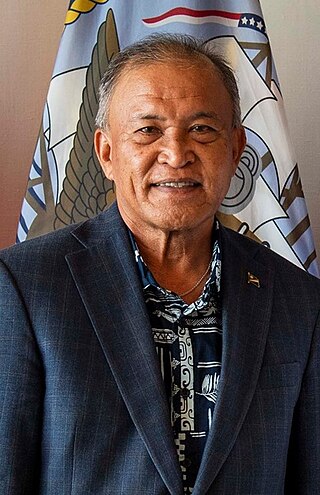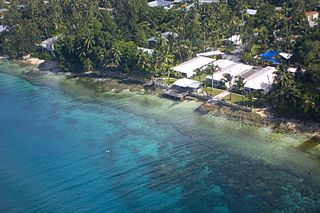
The Marshall Islands, officially the Republic of the Marshall Islands, is an island country west of the International Date Line and north of the equator in the Micronesia region in the Northwestern Pacific Ocean. The territory consists of 29 coral atolls and five islands, divided across two island chains: Ratak in the east and Ralik in the west. 97.87% of its territory is water, the largest proportion of water to land of any sovereign state. The country shares maritime boundaries with Wake Island to the north, Kiribati to the southeast, Nauru to the south, and the Federated States of Micronesia to the west. The capital and largest city is Majuro, home to approximately half of the country's population.
The demographics of the Marshall Islands include data such as population density, ethnicity, health of the populace, economic status, religious affiliations and other aspects of the population.
Austronesian settlers arrived in the Marshall Islands in the 2nd millennium BC, but there are no historical or oral records of that period. Over time, the Marshallese people learned to navigate over long ocean distances by walap canoe using traditional stick charts.

Springdale is the fourth-most populous city in Arkansas, United States. It is located in both Washington and Benton counties in Northwest Arkansas. Located on the Springfield Plateau deep in the Ozark Mountains, Springdale has long been an important industrial city for the region. In addition to several trucking companies, the city is home to the world headquarters of Tyson Foods, the world's largest meat producing company. Originally named Shiloh, the city changed its name to Springdale when applying for a post office in 1872. It is included in the four-county Northwest Arkansas Metropolitan Statistical Area, which is ranked 102nd in terms of population in the United States with 546,725 in 2020 according to the United States Census Bureau. The city had a population of 84,161 at the 2020 Census.

Johnson is a city in Washington County, Arkansas, United States. The community is located in the Ozark Mountains and is surrounded by valleys and natural springs. Early settlers took advantage of these natural features and formed an economy based on mining lime, the Johnson Mill and trout. Although a post office was opened in the community in 1887, Johnson did not incorporate until it required the development of a city government to provide utility services in 1961. Located between Fayetteville and Springdale in the heart of the rapidly growing Northwest Arkansas metropolitan statistical area, Johnson has been experiencing a population and building boom in recent years, as indicated by a 46% growth in population between the 2000 and 2010 censuses.

Bikini Atoll, known as Eschscholtz Atoll between the 1800s and 1946, is a coral reef in the Marshall Islands consisting of 23 islands surrounding a 229.4-square-mile (594.1 km2) central lagoon. The Atoll is at the northern end of the Ralik Chain, approximately 530 miles (850 km) northwest of the capital Majuro.

Enewetak Atoll is a large coral atoll of 40 islands in the Pacific Ocean and with its 296 people forms a legislative district of the Ralik Chain of the Marshall Islands. With a land area total less than 5.85 square kilometers (2.26 sq mi), it is no higher than 5 meters (16.4 ft) and surrounds a deep central lagoon, 80 kilometers (50 mi) in circumference. It is the second-westernmost atoll of the Ralik Chain and is 305 kilometers (190 mi) west from Bikini Atoll.
The Micronesians or Micronesian peoples are various closely related ethnic groups native to Micronesia, a region of Oceania in the Pacific Ocean. They are a part of the Austronesian ethnolinguistic group, which has an Urheimat in Taiwan.

Pacific Islander Americans are Americans who are of Pacific Islander ancestry. For its purposes, the United States census also counts Aboriginal Australians as part of this group.
Springdale Public Schools is the public school district for students of primary and secondary education in Springdale, Arkansas and surrounding areas. The district contains three high schools, four junior highs, four middle schools, eighteen elementary schools, and a school of innovation. Established in 1884, the district and its schools are accredited by AdvancED. It is the state's largest school district, with more than 23,000 students.
Micronesian Americans are Americans who are descended from people of the Federated States of Micronesia. According to the 2020 US Census, a total of 21,596 residents self-identified as having origins in the country, which consists of four states. More than half of these residents identified their origin as Chuuk State (12,464) with the rest as follows: 4,918 people from Pohnpei, 2,066 from Yap, and 2,148 people from Kosrae.

David Kabua is a Marshallese politician who served as President of the Marshall Islands from 2020 to 2024. He has represented Wotho Atoll in the Legislature of the Marshall Islands since 2008 and served terms as Minister of Health and Internal Affairs.

Hilda Cathy Heine is a Marshallese educator and politician who has served as the president of the Marshall Islands since 2024, having previously served from 2016 to 2020. Prior to assuming office, she served as the Minister of Education. She was the first individual from the Marshall Islands to earn a doctorate degree, and the founder of the women's rights group Women United Together Marshall Islands (WUTMI).

Runit Island is one of forty islands of the Enewetak Atoll of the Marshall Islands in the Pacific Ocean. The island is the site of a radioactive waste repository left by the United States after it conducted a series of nuclear tests on Enewetak Atoll between 1946 and 1958. There are ongoing concerns around deterioration of the waste site and a potential radioactive spill.

Kathy Jetn̄il-Kijiner is a poet and climate change activist from the Marshall Islands.

Climate change in the Marshall Islands is a major issue for the country. As with many countries made up of low-lying islands, the Marshall Islands is highly vulnerable to sea level rise and other impacts of climate change. The atoll and capital city of Majuro are particularly vulnerable, and the issue poses significant implications for the country's population. These threats have prompted Marshallese political leaders to make climate change a key diplomatic issue, who have responded with initiatives such as the Majuro Declaration.

Marshallese cuisine comprises the fare, foods, beverages and foodways of the Marshall Islands, including its food-related customs and traditions. Common indigenous and traditional foods include breadfruit, coconut, bananas, papaya, seafood, pandanus and bwiro. Additional imported foods, such as rice and flour, are also a part of people's diets and contribute to the cuisine as well. The practice of food preservation is a part of the history of the islands, and continues to occur today.
"Dear Matafele Peinem" is a poem by the Marshallese poet Kathy Jetn̄il-Kijiner. Written in English, the poem is a letter to her then seven month old daughter, Matafele Peinem. The poem is most notable for its having been read aloud by Jetn̄il-Kijiner at the opening ceremony of the 2014 UN Climate Summit, held at the United Nations headquarters in New York in September 2014; it received a standing ovation from the gathered delegates which lasted over one minute.

Tina Stege is the Climate Envoy for the Marshall Islands (RMI). The RMI is one of the countries in the world most vulnerable to climate change, mainly as a result of rising sea levels. Among other meetings, Stege has represented her country at the 2019 United Nations Climate Change Conference (COP25) held in Madrid, Spain, the 2021 Conference (COP26) held in Glasgow, Scotland and the 2022 Conference (COP27) held in Sharm El Sheikh, Egypt. She has also been a spokesperson for the RMI on the impacts of nuclear testing.
There is a population of Marshallese people in Northwest Arkansas, concentrated in Springdale.













